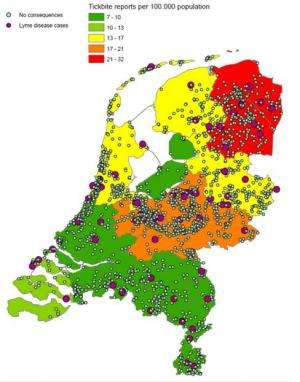Large-scale study of preventive antibiotic usage against Lyme disease

Today, at the start of the "Tick Week", the National Institute for Public Health and the Environment (RIVM) and Wageningen University are commencing a large-scale study to discover whether preventive use of antibiotics can stop Lyme disease developing after a tick bite. Of the more than 3400 ticks that were sent to RIVM via Tekenradar.nl (Tick radar) last year, more than 20% turned out to be infected with the Borrelia bacteria which can cause Lyme disease. Around 3% of the people bitten by ticks developed Lyme disease.
It is not yet clear to what extent the advantages of preventive antibiotic therapy (possibly less Lyme disease cases) outweigh the disadvantages (side effects of and increased resistance to antibiotics). That is the reason for asking people, who register a tick bite on Tekenradar.nl and send the tick to the RIVM, to take part in this research. The participants will be divided into two groups. One group will be asked – provided the family doctor agrees – to take a single dose of antibiotics within three days of removing the tick. The other group should not take antibiotics. The research is expected to last four years.
Annually between 20,000 and 30,000 people are diagnosed with Lyme disease in The Netherlands, over 130 cases per 100,000 persons per year. Tekenradar.nl was started a year ago with the aim of determining how often Lyme disease develops after a tick bite. This website – with more than 7,000 registrations of tick bites and more than 3,400 ticks sent in – became the world's biggest survey of the risk of developing Lyme disease after a tick bite. The large numbers contributing to Tekenradar.nl make it possible to extend the research and to look for an answer to the frequently asked question: should people receive preventive antibiotics after being bitten?
Of the 2828 people who sent in a tick in 2012 and filled in a questionnaire on Tekenradar.nl every three months, 2.7 % developed Lyme disease. Of those, 80% developed only erythema migrans (red, ring-shaped skin rash) while 20 % had a more serious form of the disease. The symptoms developed mostly (91 %) within three months.
As 22% of the ticks sent to RIVM were infected with the Borrelia bacteria, the conclusion is that being bitten by an infected tick does not necessarily result in Lyme disease.
Relative numbers of inhabitants registering tick bites were the highest in the province of Drenthe, followed by Groningen, Utrecht and Gelderland. The province where the most people became ill after a tick bite was, relatively speaking, Utrecht. Flevoland had the fewest.


















